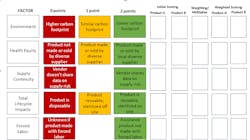E-VALUE-ating Products Across Environmental and Socio-Economic Factors
In the April 2023 edition of Value.Delivered, I wrote a column entitled “What Delivers the Value in Value Analysis,” which recapped a webinar1 on how sourcing professionals are starting to evaluate more than just cost and efficacy, including broader environmental and socio-economic factors, such as:
· How well a vendor manages and shares information on upstream risks to supply continuity
· The overall environmental impact of a product across its lifecycle, from production to disposal
· Whether purchasing a specific product supports businesses in disadvantaged communities
· Assurances that a product is not made with forced labor
Liz Eisenberg, RN, who leads clinical value analysis for Scripps Health, participated in the webinar and noted how the factors to consider will vary by both the product category and the larger strategic objectives of an organization. For example, for some organizations choosing products that reduce greenhouse gas emissions may be more important, while for others, procuring products from local, diverse suppliers may top the list. She envisioned a rubric where different criteria could be given differential weighting depending on the product category and/or strategic priorities.
A clinical procurement nurse in the U.K. was thinking along the same lines when she developed a tool to compare the environmental and social value of products. Clare Nash, who works with Sandwell and West Birmingham NHS Trust and The Dudley Group NHS Foundation Trust, developed the tool in response to new regulations in the U.K. that require decisions on all tenders to give 10 percent weighting to how a contract will deliver social value, as well as increasing requirements for suppliers to the National Health Service (NHS) to reduce the greenhouse gas (GHG) emissions associated with their operations and product lifecycles. The social value considerations must include ways to mitigate climate change, as well as other benefits that can include increasing employment and reducing health and economic disparities in local communities. Clare’s decision support tool is featured in a recent article in the peer-reviewed journal, Nursing Times.2
As the article points out, the GHG emissions associated with the total lifecycle for products used in healthcare operations are significant contributors to climate change. Clinical and supply chain professionals can play an important role in sourcing products with a lower carbon footprint, if they have the data and tools to support those decisions.
Nash’s tool is relatively simple to use, incorporating a stoplight approach. Procurement professionals can evaluate different products by assigning red, yellow, and green measurements across six categories (energy, water, waste, transport emissions, whole life costs, and social value). For example, a product that requires more energy or water use would score red, while one with similar or lower resource usage would be rated as yellow or green respectively. The colors red, yellow, and green are then correlated to the scores of 0, 1, or 2, respectively, allowing the products being compared to each be given a total numerical score. When no data is available, the score for a particular factor is zero. You can view a PDF copy of Nash’s decision support tool here.
While Nash’s tool currently only considers environmental and some social factors, the approach taken could be extended to some of the other factors outlined above. Taking Eisenberg’s idea into account, the factors could be changed, along with the weighting (or multiplier), to take into account what is most relevant to a particular product category and/or an organization’s strategic objectives.
An abridged and highly simplified version of such a tool is depicted below.
Using this chart, an organization can decide to put a higher multiplier on environmental factors when evaluating anesthesia gases, given the wide range in the GHG emissions across product choices. Organizations that have signed the White House Climate Pledge3 might also rank environmental factors higher in order to meet commitments to lower their carbon footprints. On the other hand, an organization committed to economic development in local, disadvantaged communities might rank health equity factors higher for those products that can be sourced locally.
To make this concept work, value analysis and sourcing professionals need to be fully aware of their organization’s strategic objectives, while also working with their internal subject matter experts and suppliers to gather the data needed to make informed calculations. It’s true, in many cases we do not yet have all of the information needed, but envisioning a tool such as this could be the first step toward creating even closer alignment among various stakeholders, both internally and across the supply chain, with the ultimate beneficiaries patients and the planet.
References
1. Link to webinar recording: https://gateway.on24.com/wcc/eh/2552798/lp/4030110/from-equity-and-the-environment-to-resiliency-and-risk-management-future-considerations-for-value-analysisstrategic-sourcing-professionals-cvahp-continuing-education-credit-available
2. Nash C (2023) It’s not easy being green – a tool for choosing sustainable clinical products. Nursing Times [online] 119:8.
3. Health Sector Pledge | HHS.gov
About the Author

Karen Conway
CEO, Value Works
Karen Conway, CEO, ValueWorks
Karen Conway applies her knowledge of supply chain operations and systems thinking to align data and processes to improve health outcomes and the performance of organizations upon which an effective healthcare system depends. After retiring in 2024 from GHX, where she served as Vice President of Healthcare Value, Conway established ValueWorks to advance the role of supply chain to achieve a value-based healthcare system that optimizes the cost and quality of care, while improving both equity and sustainability in care delivery. Conway is former national chair of AHRMM, the supply chain association for the American Hospital Association, and an honorary member of the Health Care Supplies Association in the UK.

